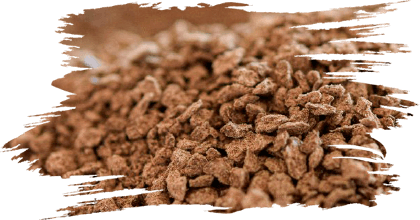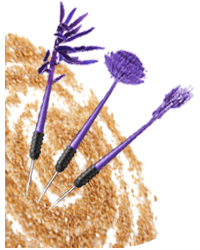Jog Raj*, Hunor Farkaš, Svetlana Ćujić, Tobias Steiner, Goran Grubješić, and Marko Vasiljević
PATENT CO, DOO., Vlade Ćetkovića 1A, 24 211, Mišićevo, Serbia
*Corresponding author: [email protected]
Dietary fiber is commonly known as the part of the diet that is not broken down by the animal’s digestive enzymes.
The major carbohydrates in any feed are generally polysaccharides which include:
- Starch
- Cellulose
- Hemicellulose
- Pectins
- Fructans
- Lignin
These last four make up the dietary fiber.
In animal feed, wheat bran, corn bran, rice bran, soy hulls, sugar beet pulp, and lignocellulose (such as OptiCell® or FibreCell®) are commonly used as a fiber source.

 Animal feed ingredients can be contaminated with contaminants and mycotoxins are among the main contaminants that can be found in all feed materials including fiber sources.
Animal feed ingredients can be contaminated with contaminants and mycotoxins are among the main contaminants that can be found in all feed materials including fiber sources.

The aim of this study was to analyse the presence of mycotoxins using LC-MS/MS in the following fiber sources:
 Corn bran
Corn bran Dried distillers’ grains (DDGS)
Dried distillers’ grains (DDGS) Rice bran
Rice bran Soyhull
Soyhull Wheat bran
Wheat bran Sunflower meal
Sunflower meal OptiCell®
OptiCell® FibreCell®
FibreCell®
 These fiber samples for mycotoxins analysis were received from different regions of Argentina, Austria, Chile, Costa Rica, Ecuador, South Korea, Mexico, Peru, Philippines, Serbia, Taiwan, and Turkey between June 2023 and March 2024.
These fiber samples for mycotoxins analysis were received from different regions of Argentina, Austria, Chile, Costa Rica, Ecuador, South Korea, Mexico, Peru, Philippines, Serbia, Taiwan, and Turkey between June 2023 and March 2024.Approximately 500 samples were analysed for multiple mycotoxins by LC-MS/MS triple quadrupole (Agilent 6460 series) using a multi-mycotoxin method for quantification of all mycotoxins present:

 Aflatoxins (AFB1, AFB2, AFG1, and AFG2)
Aflatoxins (AFB1, AFB2, AFG1, and AFG2) Deoxynivalenol (DON), 3-acetyl, deoxynivalenol (3-ADON), and 15-acetyl deoxynivalenol (15-ADON)
Deoxynivalenol (DON), 3-acetyl, deoxynivalenol (3-ADON), and 15-acetyl deoxynivalenol (15-ADON) Fumonisins (FB1, FB2, and FB3)
Fumonisins (FB1, FB2, and FB3) Nivalenol (NIV)
Nivalenol (NIV) Ochratoxin A (OTA)
Ochratoxin A (OTA) T-2 toxin and HT-2 toxin
T-2 toxin and HT-2 toxin Zearalenone (ZEN), α-zearalenol (α-ZEL), β-zearalenol (β-ZEL), and zearalanone (ZAN)
Zearalenone (ZEN), α-zearalenol (α-ZEL), β-zearalenol (β-ZEL), and zearalanone (ZAN)
 Beauvericine (BEA)
Beauvericine (BEA) Diacetoxyscirpenol (DAS)
Diacetoxyscirpenol (DAS) Enniatins (ENNA, ENNA1, ENNB u ENNB1)
Enniatins (ENNA, ENNA1, ENNB u ENNB1) Fusaric acid (FA)
Fusaric acid (FA) Monilformin (MON)
Monilformin (MON)
The mycotoxin results for each fiber are as shown below.

OptiCell® and FibreCell®
No mycotoxins were found in any of the OptiCell® and FibreCell® samples.
 This means that in OptiCell® and FibreCell® AFB1, AFB2, AFG1, AFG2, DON, 3-ADON, 15-ADON, FB1, FB2, FB3, NIV, OTA, T-2 toxin, HT-2 toxin, ZEN, α-ZEL, β-ZEL, ZAN, BEA, DAS, ENNA, ENNA1, ENNB, ENNB1, FA, and MON were not detected.
This means that in OptiCell® and FibreCell® AFB1, AFB2, AFG1, AFG2, DON, 3-ADON, 15-ADON, FB1, FB2, FB3, NIV, OTA, T-2 toxin, HT-2 toxin, ZEN, α-ZEL, β-ZEL, ZAN, BEA, DAS, ENNA, ENNA1, ENNB, ENNB1, FA, and MON were not detected.

Corn bran 
The analysis of corn bran samples between June 2023 and March 2024 from Costa Rica, Korea, Mexico, Philippines, Serbia, Taiwan, and Turkey showed that all the samples (100%) were contaminated with more than one mycotoxin.
⇰ All the samples had presence of at least 5 mycotoxins per sample.
Table 1 shows that FB1, FB2, and FB3 were detected in 100% of the samples (high averages for FB1: 4790 ppb), while AFB1 appeared in 98% of the samples, DON in 43%, and OTA in 35% of the samples.
Among emerging and other mycotoxins, FA and BEA (98% of the samples), MON (50% of the samples), and enniatins (13-46% of the samples) were detected.
Overall, corn bran samples showed a significant occurrence of multiple mycotoxins.

Table 1. Mycotoxin contamination levels (ppb) in corn bran samples.
DDGS ![]()
DDGS samples from Argentina, Mexico, and Serbia were contaminated with more than one mycotoxin per sample.
⇰ All the tested samples showed the presence of more than 5 mycotoxins per sample.
Table 2 shows that FB1, FB2, and FB3 were detected in 91% of samples (high averages, for FB1: 1080 ppb), while DON appeared in 78%, ZEN in 70%, AFB1 in 52%, and OTA in 17% of the DDGS samples.
Among emerging and other mycotoxins, BEA (96% of the samples), FA (87% of the samples), enniatins (9-39% of the samples), and MON (30% of the samples) were detected.

Table 2. Mycotoxin contamination levels (ppb) in DDGS samples.

Rice bran 
The analysis of rice bran samples between June 2023 and March 2024 from the Philippines, Taiwan, Korea, and Peru showed the occurrence of more than one mycotoxin per sample.
⇰ All the samples showed the presence of 4 or more mycotoxins per sample.
Table 3 shows that AFB1 appeared in 73% of the samples, whereas FB1 was detected in 64%, OTA in 18%, and ZEN in 9% of the rice bran samples.
Among emerging and other mycotoxins, FA (73% of the samples), BEA (55% of the samples), DAS (45% of the samples), MON (18% of the samples), and enniatins (9% of the samples) were detected.

Table 3. Mycotoxin contamination levels (ppb) in rice bran samples.

Soy hull 
The analysis of soy hull samples between June 2023 and March 2024 from Costa Rico, Mexico, and Korea demonstrated the occurrence of more than one mycotoxin per sample.
⇰ All the samples had more than 2 mycotoxins up to a maximum of 7 mycotoxins per sample.
Table 4 shows that FB1 was detected in 50% of the soy hull samples.
Among emerging and other mycotoxins, BEA was detected in 100% of the samples, whereas enniatins were detected in more than a third of the samples.

Table 4. Mycotoxin contamination levels (ppb) in soy hull samples.

Wheat bran 
The analysis of wheat bran samples between June 2023 and March 2024 from Austria, Argentina, Chile, Costa Rica, Ecuador, Korea, Mexico, Peru, Philippines, and Serbia showed that 100% of the samples were contaminated with a minimum of 3 mycotoxins to a maximum of 11 mycotoxins per sample.
Table 5 shows that DON was detected in 78% of the samples (with an average of 518 ppb), whereas FB1 and FB2 were detected in 24% and 10% of the samples, respectively, ZEN in 5%, and AFB1 and OTA in 4% of the wheat bran samples.
Among emerging and other mycotoxins, enniatins (95% of the samples), BEA (83% of the samples), and FA (43% of the samples) were detected.

Table 5. Mycotoxin contamination levels (ppb) in wheat bran samples.

Sunflower meal 
The analysis of sunflower meal samples between June 2023 and March 2024 from Austria, Serbia, and Turkey showed that 25% of the samples were not comminated with mycotoxins, whereas 25% were found to contain one mycotoxin and 50% of the samples contained more than one mycotoxin per sample.
Table 6 shows that AFB1 and OTA with an average of 2 ppb and 5 ppb, respectively, were detected in 50% of tested samples.
Among emerging and other mycotoxins, BEA (50% of the samples), FA (38% of the samples), and ENNB (25% of the samples) were detected.

Table 6. Mycotoxin contamination levels (ppb) in sunflower meal.

CONCLUSIONS 
The main conclusions from the analysis of corn bran, DDGS, rice bran, soyhull, wheat bran, sunflower meal, OptiCell® and FibreCell® for mycotoxins are:
 OptiCell® and FibreCell® do not contain any mycotoxins and can be used as a mycotoxin-free fiber source in animal nutrition.
OptiCell® and FibreCell® do not contain any mycotoxins and can be used as a mycotoxin-free fiber source in animal nutrition.
All fiber materials (corn bran, DDGS, rice bran, soyhull, wheat bran, and sunflower meal) were contaminated with multiple mycotoxins.
 Among these, corn bran, DDGS, rice bran and wheat bran were highly contaminated with 3-11 mycotoxins per sample.
Among these, corn bran, DDGS, rice bran and wheat bran were highly contaminated with 3-11 mycotoxins per sample.

Corn bran samples (100%) were contaminated with more than 5 mycotoxins per sample.
 FB1, with a higher average (4790 ppb) was the most predominant mycotoxin detected in corn bran samples.
FB1, with a higher average (4790 ppb) was the most predominant mycotoxin detected in corn bran samples. Among emerging mycotoxins, FA, BEA and enniatins were detected with a higher occurrence in corn bran samples.
Among emerging mycotoxins, FA, BEA and enniatins were detected with a higher occurrence in corn bran samples.
DDGS samples (100%) were contaminated with more than 5 mycotoxins per sample.
 FB1, FB2, and FB3 were detected in 91% of the samples (high averages for FB1: 1080 ppb), while DON and AFB1 were detected in 78% and 52% of the DDGS samples, respectively.
FB1, FB2, and FB3 were detected in 91% of the samples (high averages for FB1: 1080 ppb), while DON and AFB1 were detected in 78% and 52% of the DDGS samples, respectively. FA, BEA, and MON were also detected in DDGS samples.
FA, BEA, and MON were also detected in DDGS samples.
The analysis of rice bran samples from the Philippines, Taiwan, Korea, and Peru was found to contain more than 4 mycotoxins per sample.
 AFB1, FB1, FB2, FB3, OTA, BEA, DAS, FA, and MON were the main mycotoxins detected.
AFB1, FB1, FB2, FB3, OTA, BEA, DAS, FA, and MON were the main mycotoxins detected.
The analysis of wheat bran samples between June 2023- March 2024 from Austria, Argentina, Chile, Costa Rica, Ecuador, Korea, Mexico, Peru, Philippines, and Serbia, showed that 100% of the samples were contaminated 1 – 11 mycotoxins (AFB1, DON, FB1, FB2, OTA, ZEN, BEA, enniatins, FA) per sample.






 Micotoxicosis prevention
Micotoxicosis prevention